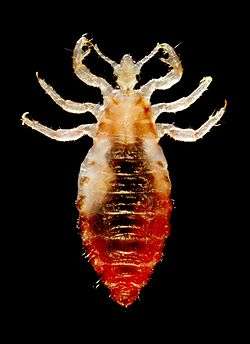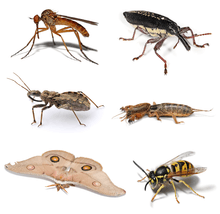Paraneoptera
| Paraneoptera | |
|---|---|
 | |
| Magicicada septendecim, a cicada (Hemiptera) | |
| Scientific classification | |
| Kingdom: | Animalia |
| Phylum: | Arthropoda |
| Class: | Insecta |
| Subclass: | Pterygota |
| Infraclass: | Neoptera |
| Superorder: | Paraneoptera |
| Orders | |
| |
Paraneoptera is a monophyletic superorder of insects which includes four orders, the bark lice, true lice, thrips, and hemipterans, the true bugs.[1] The mouthparts of the Paraneoptera reflect diverse feeding habits. Basal groups are microbial surface feeders, whereas more advanced groups feed on plant or animal fluids.[1]
Hemiptera
Hemiptera /hɛˈmɪptərə/ is an order of insects most often known as the true bugs (cf. bug), comprising around 50,000–80,000 species of cicadas, aphids, planthoppers, leafhoppers, shield bugs, and others. They range in size from 1 millimetre (0.039 in) to around 15 centimetres (5.9 in), and share a common arrangement of sucking mouthparts.
Psocoptera
Psocoptera, the bark lice, include 4,400 described species arranged in 3 suborders, Trogiomorpha, Troctomorpha, and Psocomorpha. There are 50 families of bark lice with over 200 genera. This is the first insect order to show the beginnings of a transition to sucking mouthparts. It is sister group to the Phthiraptera.
Bark lice are found on foliage, under bark, or in leaf litter. Most species are micobial surface feeders, some species feed on dead insects and a few species, known as book lice, eat paper products. Many species live gregariously. Mating behavior can be elaborate.
Phthiraptera
Phthiraptera, the lice, includes 5,000 described species divided into 4 suborders. The Amblycera is the most basal group and parasitize birds and mammals. The Ischnocera is the largest suborder and parasitize mostly birds and some groups of mammals. The Rhynchophthirina, the elephant lice, consists of only 3 species that parasitize elephants and wild pigs in Africa. The Anoplura (sucking lice) parasitize only mammals.
The body of a louse is dorsoventrally flattened and the eyes are absent or nearly so. The legs are strong for holding onto fur or feathers of the host. Amblycera have chewing mouthparts, and Anoplura have true sucking mouthparts with stylets. Chewing lice feed on feathers, hair and skin surface detritus, whereas sucking lice feed exclusively on blood. Most species of lice are host specific, with the sucking lice being more host specific than chewing lice. There is strong evidence for host-parasite coevolution in some groups. Because lice are wingless, transfer between hosts usually involves direct contact during mating, brooding and nursing of young, sharing of communal nest sites or even during predator-prey interactions. Lice have the fewest number of life stages of any insect (egg, 3 larval instars, and adult).
Thrips

Order Thysanoptera includes 5,500 species classified into two suborders distinguished by the ovipositor. Terebrantia have a well-developed conical ovipositor, while the Tubulifera do not. Instead the abdomen is drawn out in the shape of a tube. These insects are called thrips.
The mouth is in the form of an asymmetrical mouth cone, consisting of piercing stylets. Thrips have unique eversible bladders on their tarsi that provide adhesion to the substrate. Thrips are commonly found on and in flowers. Most species are phytophagous, feeding on flowers. Some species feed on fungi and a few species are predaceous. Development in thrips is unique. In the Terebrantia the egg stage is followed by 2 larval instars, 1 “prepupal” instar, a “pupal” instar and the adult stage. The prepupal and pupal stages are quiescent and have rudimentary wings. In the Tubulifera there are two “prepupal” instars and one “pupal” instar. Wing rudiments are not present in the first “prepupal” stage. Social behavior ranges from solitary to eusocial with reproductive division of labor.
References
- 1 2 David A. Grimaldi & Michael S. Engel (2005). "The Paraneopteran Orders". Evolution of the Insects. Volume 1 of Cambridge Evolution Series. Cambridge University Press. pp. 261–330. ISBN 978-0-521-82149-0.

